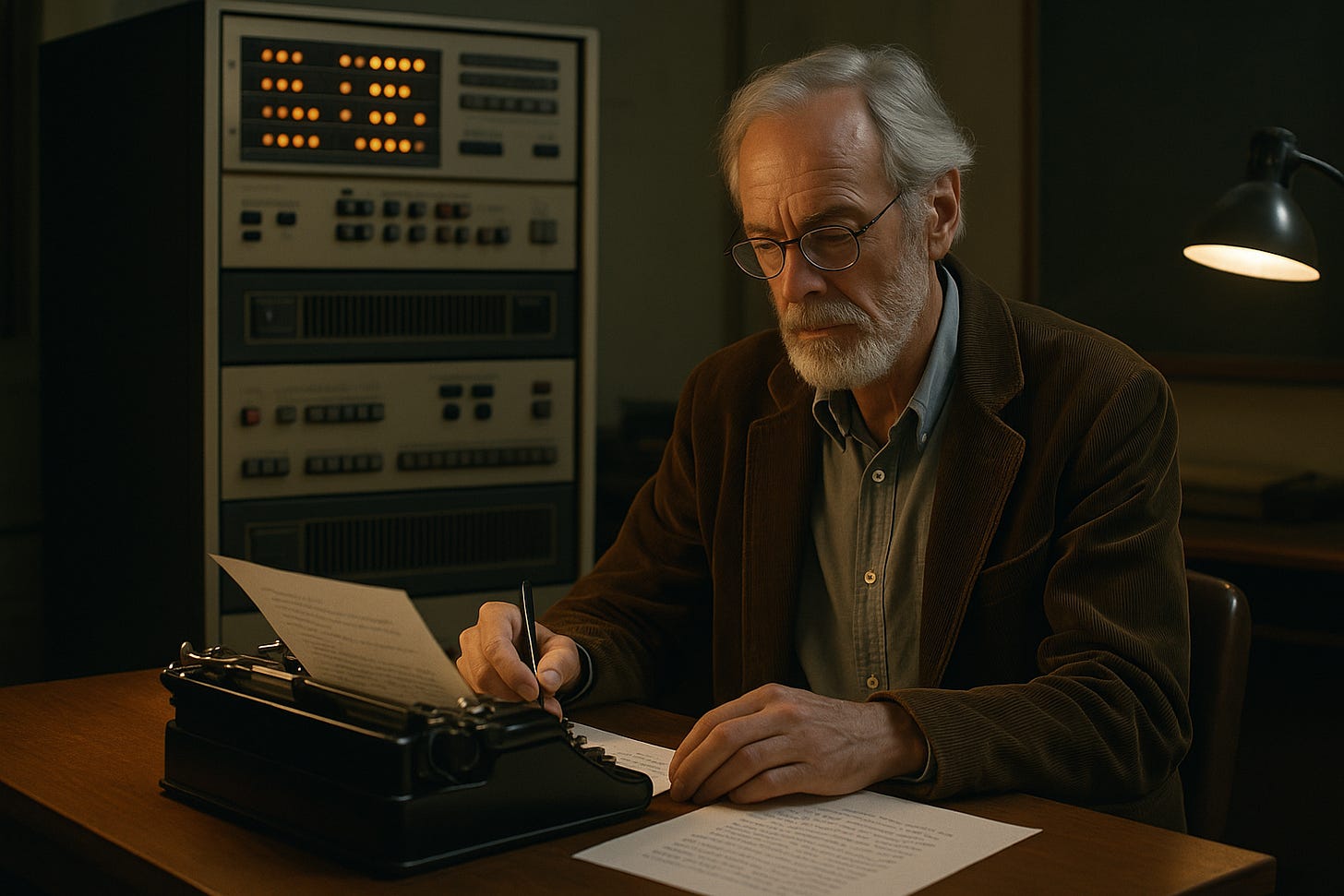five top things i’ve been reading (forty-ninth edition)
the latest in a regular 'top 5' series
Political Beliefs: A Philosophical Introduction, Oliver Traldi
Three new novels
The computer poetry of J. M. Coetzee’s early programming career, Rebecca Roach
Who was the first algorithmic composer?, Igor Toronyi-Lalic
Harpers Ferry 1931 railroad bridge
This is the forty-ninth in a weekly series. As with previous editions, I’ll move beyond things I’ve been reading, toward the end.
1) On Wednesday, I published a new episode of my philosophy podcast, Working Definition. This latest episode is on the topic of politics, and it stars my excellent friend Oliver Traldi. At the heart of the episode is a discussion about the ideas Oliver advances in the opening chapter of his recent book, Political Beliefs: A Philosophical Introduction (2024). Here’s a sample:
OLIVER
So in the first chapter of my book, I throw out a few potential sort of families of definitions.
REBECCA
Yeah, I enjoyed reading this chapter. I should say I only read the first chapter, because I didn’t want to know… I didn’t want to wreck the episode, wreck the story! I want to find out what conclusion you come to in the rest of the book, but I’m going to save that until after we have this conversation.
But I enjoyed that first chapter. I thought it was very clear.
OLIVER
I tried my best.
REBECCA
It was a clear discussion about how to define things, aside from anything else.
OLIVER
Yeah, although certainly doesn’t come up with an answer…
REBECCA
No, but you tested out some of these…
OLIVER
I tested out a lot.
REBECCA
But actually, before we go on to these three groups of types of definition, or things that people claim politics is about, I think is how you put it at one point. I was just wondering about the relation between the word ‘politics’ and the word ‘political’.
Is this a good way to getting into thinking about what politics is — to think about the political? Are these two things the same? How do they relate? What do you see the value being of starting with ‘the political’ rather than with ‘politics’?
To find out what comes next, you can read or listen to the rest of the episode here. I recommend you also check out Oliver’s book.
2) These days I rarely read new novels straight through, even though I’m lucky to be able to read very quickly. This says something about my views about much contemporary literary fiction. On Tuesday, however, I’m pretty sure that I will read a new novel straight through, because that’s the day I’m expecting my copy of the third instalment of Solvej Balle’s On the Calculation of Volume series. I can’t wait. Meantime, here are my thoughts on books one and two.
A couple of new novels I’ve been reading, on-and-off, over the past couple of weeks are Brandon Taylor’s Minor Black Figures and Kiran Desai’s The Loneliness of Sonia and Sunny — both published this autumn. I’ll write properly about them both sometime soon. But while the Desai is capturing my attention much more strongly than anything else I’ve tried by her, my favourite Taylor novel (indeed, one of my favourite new novels of the past decade) is still The Late Americans (2023).
3) The topic of favourite novels brings me to J.M. Coetzee. I love many of Coetzee’s novels, particularly Disgrace (1999). And I think his novella The Lives of Animals (also 1999) is an important work of moral philosophy. But a few days ago, I read a 2017 Rebecca Roach article about Coetzee’s work in the 1960s as a computer programmer.1
In particular, Roach’s article is about how Coetzee instructed a supercomputer to write poems, by programming it to “select words from a set vocabulary and create repetitive lines”. This was immediately interesting to me because lately I’ve been thinking hard about the value of AI art. Indeed, earlier this week I published a piece here setting out why I care about AI poetry differently from how I care about poetry by humans — even though I care about AI poetry a lot.
Along the way, in that piece, I drew a loose distinction between “art objects that have been created in collaboration with AI (such things will surely only become more common), and art objects that humans have commanded AI to create (ditto)”. The Coetzee supercomputer poems are a useful example of art objects that surely count as ‘collaborations’ but are also close to having been simply ‘commanded’. This blur gains added intrigue through Roach’s revelation that while Coetzee didn’t publish the poems in full, he “edited and included phrases from them in poetry that he did publish”. Sadly, she doesn’t tell us whether he was open about the involvement of his computer collaborator!
All this goes to underline a meta point I’m making in my piece: that as AI art objects become more mainstream, new kinds of questions about the relevance of authorship — questions separate from questions about the quality of these art objects, per se — will surely become central to aesthetics.
4) Relatedly, I just read this new FT piece, in which Igor Toronyi-Lalic argues that algorithms have been used by composers throughout most of the history of Western classical art music. It’s a good read, but I find its central claim way overblown. Early on in the piece, after having told us that Guido d’Arezzo was the first of the “algorithmic composers”, Toronyi-Lalic states that:
“Algorithms are sets of commands: if you do X, then do Y. And composers have been following commands and rules like this, employing processes, systems and maths, ever since d’Arezzo. It’s one of the great myths — a fantastically cunning act of creative self-branding — that music is an art that flows straight from the soul. Pure, organic inspiration. It’s why the advance of AI into music is seen in such apocalyptic terms.
Toronyi-Lalic goes on to offer examples of these ‘algorithmic’ processes and systems, including the use of “stock harmonic patterns” and the use of ratios inspired by the proportions of biblical temples. He goes as far as telling us that the “mechanical, algorithmic thinking underpinning AI” has “often lain at the heart” of composing.
To me, all this seems about as unhelpful as claiming that the use of grammar in writing — or the use of colour in painting — is algorithmic! I mean, okay, musical scales are fixed patterns. They are fixed patterns, which composers use, and experiment with, and build upon. So yes, in this sense, of course scales set limits. And yes, limits are also set when composers take numerical inspiration from architectural ratios, and the like. And yes, these kinds of limits — particularly the limits set by scales — can also ground compositional norms and even rules. But none of this means that all compositions interpolating such things are algorithmic! Or at least not in anywhere near the particular sense the term is generally understood today.
Okay, some of the examples Toronyi-Lalic offers — particularly, the ‘compose your own’ Mozart dice-games example, which he writes interestingly about — do come closer to this sense of ‘algorithmic’. But musical dice-games are not exactly significant within Mozart’s output, never mind within Western classical music as a whole!
That said, it’s the suggestion that twentieth-century twelve-tone composition was the apex of algorithmic composition that really risks missing the mark. I mean, it’s true that some twentieth-century twelve-tone composers did set rules for machines to create twelve-tone music in an algorithmic way. But many other twelve-tone composers embraced twelve-tone scales as a purposeful escape from the constraint of rules: as a route into writing music (writing music by themselves, that is, not by or with machines) that was free from the conservative bounds of diatonicism.
Of course, the new focus of these composers on the number twelve set its own internal limits. But these composers typically found that the kinds of harmony they could generate using twelve-tone scales were much more open to the application of their own idiosyncratic choices. That was kind of the point! And, as I mentioned in my AI poetry piece, some twelve-tone composers went even further in their search for an escape from traditional rules — using twelve-tone scales in conjunction with randomiser machines, in the aim of creating music ‘by chance’.
None of this is to deny the persistent role of rules in music, or indeed their aesthetic potential. Rather, it’s to emphasise that the societal concern that Toronyi-Lalic is trying to address in his piece — the concern that AI algorithms will make classical music more mechanistic and less human — will not be allayed by arguing that nothing new is going on.
5) I spent Friday night and Saturday daytime in Harpers Ferry. I visited it last November, too, and there are many things I like about the place. I really like how American it is, in many senses. But I especially like the bridges. Here’s a picture I took of the 1931 railroad bridge last year, when the trees were still quite red.
Thanks to GPT for the picture of Coetzee and his computer.
It was my friend Henry Oliver who recommended this article to me. As it happens, you’ll be able to hear the two of us discuss Coetzee qua philosopher in an upcoming episode of my podcast, on the topic of happiness, which we recorded on Friday..








Excellent analysis; exploring the foundational defintions of political beliefs alongside algorithmic creativity is truly intellectually stimulating.
I just had a conversation with a young friend this morning who is a very talented musician. He and I discussed how we love to feel the music. I said that I like to drive and listen. He said he cannot drive and listen as he deconstructs the music in his mind and multitasking is overwhelming. He did make an appearance on “American Idol” at age 29 in 2013 so I trust his insight!